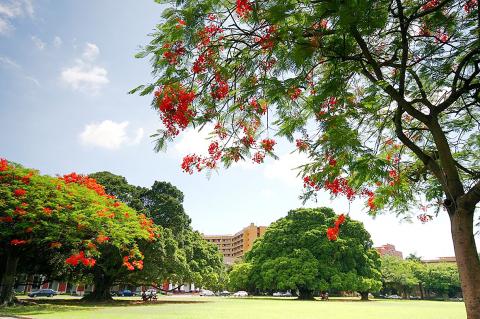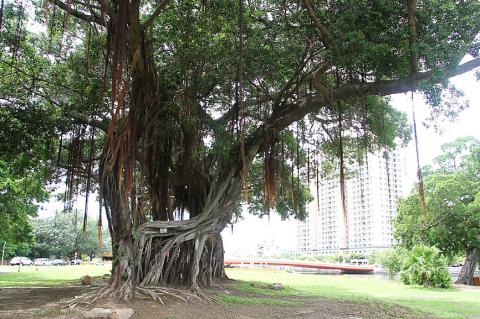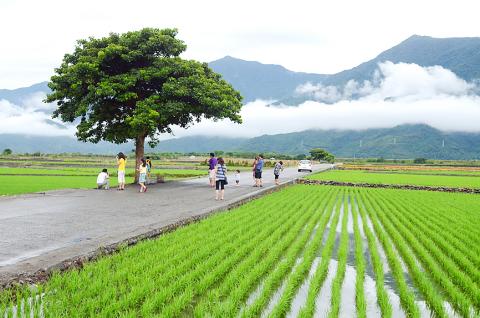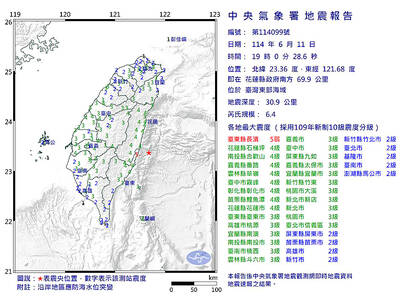While there are plenty of old banyan trees in Taiwan, none can be said to enjoy quite the same level of fame as a centennial banyan that grows at Greater Tainan’s Cheng Kung University and was the inspiration for Cathay Life Insurance Co’s tree-shaped logo.
Visitors stepping onto the university’s Guangfu campus are met with the sight of an idyllic meadow to their right, in the middle of which towers the imposing mushroom-shaped banyan. The 100-year-old tree is so massive that it dwarfs all the other banyans on campus.
It is said that the real-life Cathay Life banyan was planted by Japanese Emperor Showa in 1923 and that it is indigenous to Japan’s Kagoshima Prefecture.

Photo taken from Cheng Kung University’s Facebook page
Even so, the giant tree is not that special in the eyes of many locals, who are accustomed to the centennial banyans — a type of fig tree — ubiquitous across parks in Greater Tainan, standing out only for its sheer size.
As any celebrity knows, the road to fame often presents itself when one least expects it and so it was with the Guangfu banyan.
In 1995, Cathay Life donated NT$1 million (US$33,333) to adopt the tree and designed its trademark logo based on the tree’s mushroom-like silhouette.

Photo: CNA
Alongside the slogan: “Bury your roots deep to reach high,” the titanic banyan began appearing in print advertisements and TV commercials for the insurer nationwide, earning it overnight fame.
As a result of this publicity, tourists have swarmed to the university to marvel at the tree for the past 20 years, while the school’s administration often allows its banyan grove to be used a venue for events.
Cathay Life’s banyan has also became a landmark of Greater Tainan and a popular spot in which to play basketball, have a date or engage in a myriad of other leisure activities.

Photo: CNA
The banyan is not Taiwan’s only “celebrity” tree: A red cedar that grows at the end of Taitung County’s Brown Avenue also rose to fame, gaining nationwide recognition after Taiwanese-Japanese actor Takeshi Kaneshiro (金城武) was filmed having tea underneath it in a globally televised EVA Airways commercial earlier this year.
The cedar has since been dubbed the “Takeshi Kaneshiro Tree.”
The commercial, shot in Chihshang Township (池上), featured the superstar serving tea and cooling off under the shade of the red cedar. The ad became an overnight sensation as its depiction of leaving the busy city life behind to be immersed in nature resonated with many.
Wu Hsiu-lan (吳秀蘭), who owns the red cedar, said her father planted the tree 40 years ago so he and his buffalo could cool off in its shade.
The cedar’s popularity even prompted the Chihshang Township Office to list it as a cultural site and control traffic on the avenue running alongside it — an unprecedented move given that the avenue is listed as an agricultural road.
The tree, which has the potential of generating annual profits of up to NT$700 million, sparked a wave of panic when it was uprooted by Typhoon Matmo late last month.
Fortunately, thanks to the special attention it received from horticulturalists, it has been restored to an upright position.
Another famous banyan rivaling the Cheng Kung University landmark is the “lovey-dovey tree” that sits by the Greater Tainan canal.
The tree found instant fame after it was featured in several scenes of last year’s Taiwanese blockbuster Zone Pro Site (總舖師).
In one of the scenes, the film’s protagonists, A-hai (阿海) and Hsiaowan (小婉), a young couple, sit on top of the banyan’s roots, transforming it into a popular date spot overnight. Couples from across Taiwan now come to Greater Tainan to take pictures sitting on the tree’s roots.
Greater Tainan Tourism Bureau Director Chen Chun-an (陳俊安) said that despite the film star tree’s high profile, the city government chose not to further publicize it or establish any infrastructure in its surroundings because it wants to preserve the banyan so it continues to be the same healthy, imposing tree seen in the movie.
Stressing the importance of conservation, Chen urged visitors to bear in mind that the “lovey-dovey tree” may not be fit for climbing due to its age, suggesting that they just photograph it from a distance.

A magnitude 6.4 earthquake struck off the coast of Hualien County in eastern Taiwan at 7pm yesterday, the Central Weather Administration (CWA) said. The epicenter of the temblor was at sea, about 69.9km south of Hualien County Hall, at a depth of 30.9km, it said. There were no immediate reports of damage resulting from the quake. The earthquake’s intensity, which gauges the actual effect of a temblor, was highest in Taitung County’s Changbin Township (長濱), where it measured 5 on Taiwan’s seven-tier intensity scale. The quake also measured an intensity of 4 in Hualien, Nantou, Chiayi, Yunlin, Changhua and Miaoli counties, as well as

Credit departments of farmers’ and fishers’ associations blocked a total of more than NT$180 million (US$6.01 million) from being lost to scams last year, National Police Agency (NPA) data showed. The Agricultural Finance Agency (AFA) said last week that staff of farmers’ and fishers’ associations’ credit departments are required to implement fraud prevention measures when they serve clients at the counter. They would ask clients about personal financial management activities whenever they suspect there might be a fraud situation, and would immediately report the incident to local authorities, which would send police officers to the site to help, it said. NPA data showed

ENERGY RESILIENCE: Although Alaska is open for investments, Taiwan is sourcing its gas from the Middle East, and the sea routes carry risks, Ho Cheng-hui said US government officials’ high-profile reception of a Taiwanese representative at the Alaska Sustainable Energy Conference indicated the emergence of an Indo-Pacific energy resilience alliance, an academic said. Presidential Office Secretary-General Pan Men-an (潘孟安) attended the conference in Alaska on Thursday last week at the invitation of the US government. Pan visited oil and gas facilities with senior US officials, including US Secretary of the Interior Doug Burgum, US Secretary of Energy Chris Wright, Alaska Governor Mike Dunleavy and US Senator Daniel Sullivan. Pan attending the conference on behalf of President William Lai (賴清德) shows a significant elevation in diplomatic representation,

The Taipei City Reserve Command yesterday initiated its first-ever 14-day recall of some of the city’s civilian service reservists, who are to undergo additional training on top of refresher courses. The command said that it rented sites in Neihu District (內湖), including the Taipei Tennis Center, for the duration of the camp to optimize tactical positioning and accommodate the size of the battalion of reservists. A battalion is made up of four companies of more than 200 reservists each, it said. Aside from shooting drills at a range in New Taipei City’s Linkou District (林口), the remainder of the training would be at